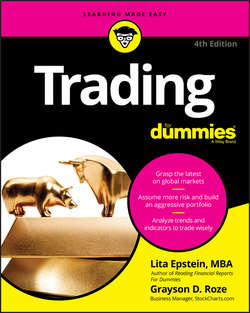Читать книгу Trading For Dummies - Lita Epstein - Страница 5
На сайте Литреса книга снята с продажи.
Part 1
Getting Started with Trading
Chapter 1
The Ups and Downs of Trading Stocks
Distinguishing Trading from Investing
ОглавлениеTrading is not the same thing as investing. Investors buy stocks and hold them for a long time – often too long, riding a stock all the way down and possibly even buying more along the way. Traders, on the other hand, hold stocks for as little as a few minutes or as long as several months, and sometimes possibly even a year or more. The specific amount of time depends on the type of trader you want to become.
Investors want to carefully balance an investment portfolio among growth stocks, value stocks, domestic stocks, and foreign stocks, along with long‐, short‐, and intermediate‐term bonds. A well‐balanced portfolio generally offers the investor a steady return of between 5 percent and 12 percent, depending on the type of investments and amount of risk he or she is willing to take.
For investors, an aggressive portfolio with a mix of 80 percent invested in stocks and 20 percent in bonds, if well balanced, can average as high as a 12 percent annual return during a 20‐year period; however, in some years, the portfolio will be down, and in others, it will go through periods of high growth. The opposite, a conservative portfolio with 20 percent invested in stocks and 80 percent in bonds, is likely to provide a yield on the lower end of the spectrum, closer to 4 percent. The volatility and risk associated with the latter portfolio, however, would be considerably less. Investors who have 10 or more years before they need to use their investment money tend to put together more‐aggressive portfolios, but those who need to live off the money tend to put together less‐aggressive portfolios that give them regular cash flows, which is what you get from a portfolio invested mostly in bonds.
As a trader, you look for the best position for your money and then set a goal of exceeding what an investor can otherwise expect from an aggressive portfolio. During certain times within the market cycle, your best option may be to sit on the sidelines and not even be active in the market. In this book, we show you how to read the signals to decide when you need to be in the market, how to find the best sectors in which to play the market, and the best stocks within those sectors.
